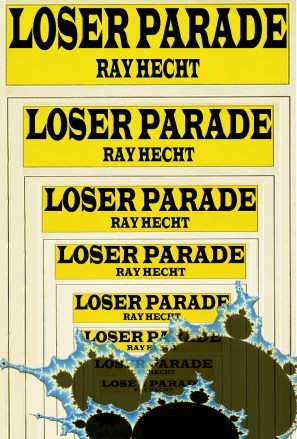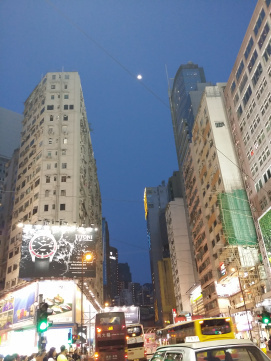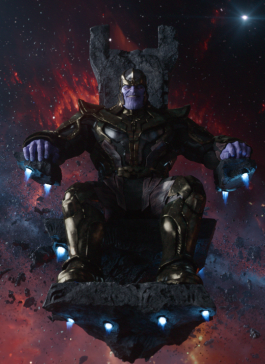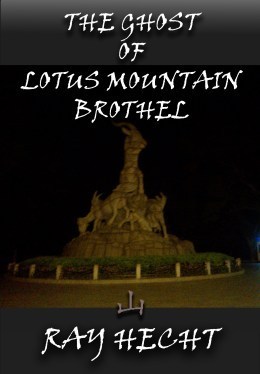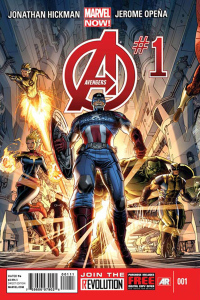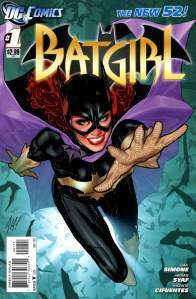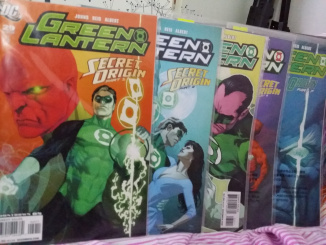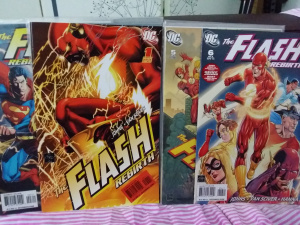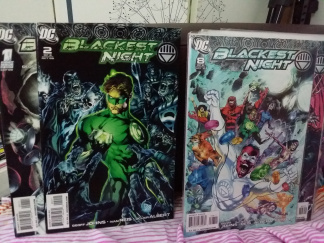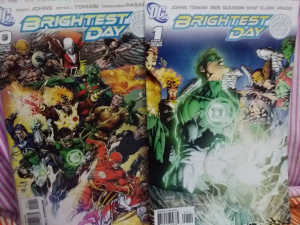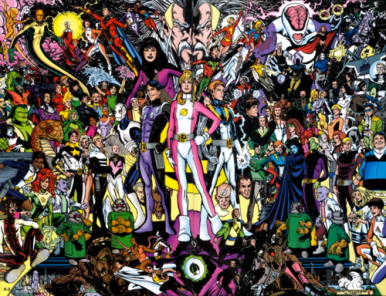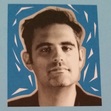Ray Hecht's Blog, page 32
May 5, 2015
Loser Parade – my first novel, now free on Amazon KDP edition
http://www.amazon.com/Loser-Parade-Ray-Hecht-ebook/dp/B00ETYSS5W
With this, the last of my free giveaways this season. Allow me to present my first novel: Loser Parade
(Well, my first halfway decent novel)
Written many years ago, so please don’t judge too harshly…
Fenton Ota is at his wit’s end. He thought he would have been more of a success at this point. What happened? He finds himself in Los Angeles an utter failure as an actor, and in the end there is nothing he can do but call Mom and go back to Ohio. The shame!
What is it they say about how you can never go home? Once back in Cincinnati with his tail between his legs, he reconnects with old pals, struggles to build himself up, and eventually embarks on a new goal: writing and directing his own play. Ostensibly based on his own “experiences.” Based on this author’s experiences. Writing about the fictional character who is him, writing about this author, writing about him, and so on. It gets a bit metafictional and postmodern.
He is, of course, doing this all for a girl. And their relationship is all based on lies. Ain’t love grand?
A tale of the creative process, the white lies that get out of proportion, and the deeper questions of just what is a story. Sometimes we are all losers, but hopefully its never too late to grow up.


May 4, 2015
Pedder Art Galleries in Hong Kong
I recently went to Hong Kong to check out some art galleries.
I highly recommend going to the Pedder Building on Pedder Street in Central. It’s very easy to get to; simply take the MTR to Central and walk out of Exit D1 and you’re right there.
From up to down: The 1st floor contains Gagaosian Gallery – 2nd floor PearlLam Galleries – 4th floor Hanart TZ Gallery – 3rd floor Ben Brown Fine Arts
The Rudolph Stingel exhibition at Gagaosian contained some interesting golden and metallic prints, large abstract scratches made from audience participation. I found it poignant that if you look directly into the reflective material you see yourself..
Click to view slideshow.
PearlLam exhibited ‘Perfection by Chance’ Yi Pai series, the space regularly presenting leading Chinese artists. Works by Qin Yufen, Su Xiaobai, Su Xinping, Tan Ping, Yang Zhilin, and Zhu Jinshi curated by Professor Gao Minglu.
Click to view slideshow.
Hanart TZ Gallary with Roundsky: paintings by Emily Cheng. Very new agey, lots of religious symbolism incorporating text into the paintings. Read closely.
And, the space had personalized arcade console with a working game!
Click to view slideshow.
Ben Brown presented Simon Birch: The Inevitable. I found these paintings very powerful. Large-scale, a painter with much talent in presenting the human form but choosing to cut up the figures, especially the faces. Seemed full of anger, almost violent, never still.
Click to view slideshow.
Some fine work up there.
All in all, it was a great day.


April 29, 2015
Free eShort Story: 411
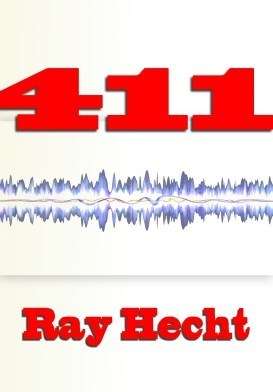
More free eBooks, do enjoy. This promotion will be lasting for several days further.
If you get anything out of this short story, tell your friends and share! And please feel free to post a review if so inclined… (As always, the Kindle app is free)
411 being an old horror tale I wrote years back, loosely based off of my time as a 411 operator. Does it disturb at all?
http://www.amazon.com/411-Ray-Hecht-ebook/dp/B00EUBZRL2
There used to be a time when people called 411 for information. But on the other side of that dial tone there may be a place of madness. A tale of revenge and the secret power of media. Be careful out there, one never knows what kind of hidden messages are leaking through the frequency.
Jacob was a simple 411 operator (back in the day, when that was a thing). A bit anxious, a bit awkward, but not dangerous. Yet when his love is spurned he decides to take matters into his own hands and discovers he has the power to change the world. Its time for revenge.
The secret underworld of 411 operators will be revealed. Note the references of William S. Burroughs and the cutup technology, albeit in audio format. Disturbing, cynical, well-researched, and maybe some mindless shock value. The point is, get ready to learn about untold depths of the 411 scene.
Telephone service jobs, don’t you miss them?


April 26, 2015
Jim Starlin – Marvel Comics 1970s and Thanos of the Power Cosmic
Previous: Marvel 2000s
Allow me to take a moment to express my fondness for the works of Jim Starlin.
Since Guardians of the Galaxy – and yes the Avengers – has become mainstream, everybody knows Drax the Destroyer and Gamora and the Infinity Gems/Stones.
Most of all, now everyone knows Thanos.
But for it goes way back. When I was a precocious teen in the 90s, I couldn’t help but fall for the Infinity Gauntlet crossover. It was so epic, so cool. Thanos the all-powerful against a horde of superheroes and space beings. Followed by the exponentially-less cool Infinity War and Infinity Crusade, it was the epitome of overblown early 90s comicbook crossovers. What better to be introduced to the grand Marvel Universe?
The real story of Jim Starlin goes back much further that that. The cosmic escapades I am describing explore one of the great long-form stories of our time, with about forty years of history.
In the 1970s Marvel Comics was on top, having surpassed DC in the previous decade’s Silver Age quality. The medium was full of wonder, although it did get ridiculous as much as it got experimental. The Defenders, Howard the Duck, Jack Kirby’s Captain America. Comics hadn’t exactly grown up by then, no Claremont X-Men yet, but there was much fun to be had in the disco era.
Jim Starlin first got his break in 1972. He wrote and drew three issues of Iron Man, in which the metallic hero fought the Blood Brother aliens. And suddenly it was revealed they were working for the master villain of all time: Thanos.
The cosmic saga had begun.
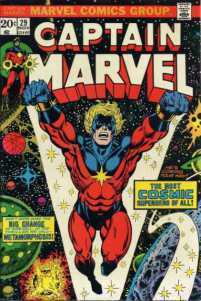
It was in the pages of Captain Marvel that the saga truly unfolded. Starting with issue 25, the eponymous Marvel character finally found his own voice. The Kree alien (actually named “Mar-Vell”) was joined by the cosmic being Eon to become a protector of the universe, and was faced off against Thanos powered by a cosmic cube. The universe was just barely saved in the end.
I came across the trade paperback collection in my youth and I’m glad I did. The Infinity crossovers of the 90s made more sense with the backstory. That was the beauty of being into superheroes, to go back and endlessly collect and learn the whole story… Baroquean really…
There was also Tbe Death of Captain Marvel, the first official graphic novel of Marvel. A sort of proto-crossover, it was simply about the Captain getting cancer and retiring from the world of the living. In typical fashion, Starlin explored themes of the afterlife and the psychedelic depiction thereof.
That was back when characters stayed dead.
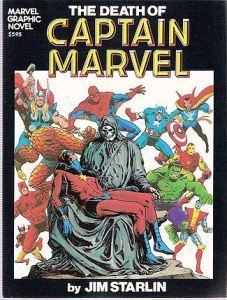
Starlin is known just as well for Adam Warlock, a random character created by Kirby, who later became a sort of Christ-like figure. The artificial humanoid died and resurrected himself a number of times, just as often to fight against Thanos as he did ally with the mad Titan. An unlikely antihero.
The original build up of the Infinity Gems in comics was harder for me to find. I tracked down some rare reprints, an unsuccessful miniseries from the mid-90s. Weird stuff. Another villain was the Magus, who was Adam Warlock from the future and had started his own evil religion. Warlock had to erase the timeline to win. I think we can all relate to these kinds of psychological adventures.
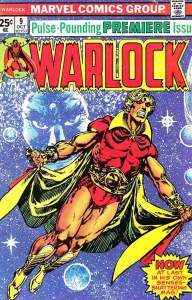
It was a grand cosmic mythology, on par with Kirby’s Fourth World. The universe was a place of alien empires, tyrants with omnipotent power, and strange abstract beings overseeing the functions of all reality.
By the way, speaking of Kirby, Jim Starlin explained in interviews that Thanos wasn’t based on Darkseid — DC’s megavillain of similar stature — but rather more based on Metron originally. What with the floating chair.
Starlin is mainly well-known for the space operas, but he also had a diverse career. Even wrote Batman in the 1980s during the Death in the Family arc with poor dead Robin II. Cosmic Odyssey for DC as well, and his own creation Dreadstar. In later years, Rann-Thanagar War comes to mind.
But Starlin’s greatness is really showcased with the cosmic stuff.
In 1989 he wrote Silver Surfer (no longer illustrating) in a prelude to the Infinity Gauntlet. The anthropomorphic nature of Death had brought Thanos back from the grave, to harness his power and bring an evil balance the universe.
Much has been written of the ‘Infinity Wars’, the return of Adam Warlock and his multiple personas. It was Marvel of the 90s okay, and it was great. The followup series Infinity Watch wasn’t that great but it did further expand the mythos, as Warlock led his own ragtag team. Pip the Troll and Moondragon may not be top-tier franchises, but Drax and Gamora certainly grew in popularity in that series. And look that them today, full-fledged movie stars!
In the early 2000s (see above), I got back into Marvel. And just in time. Jim Starlin wrote and even drew Infinity Abyss, and all that I loved was back.
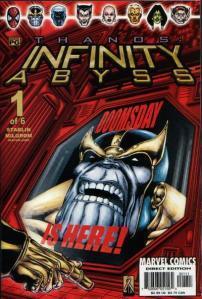
Followed by Marvel: the End (reprinted as Thanos: The End)
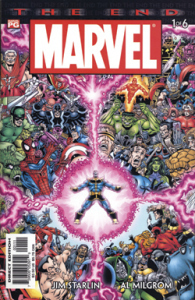
Forget about Thanos being used as a villain anywhere else, only Starlin does him justice.
These days, I’m currently enjoyed the multiple-realitied ambitiousness of the novel Infinity Revelation. There was a miniseries Hulk vs. Thanos in the middle there.
And I anxiously await the latest graphic novel Infinity Relativity. (do you sense a pattern in the titles?)
From 1972 to 2015, Jim Starlin yet rocks.
Next: I realize that in all these author profiles I’ve left out one last highly important writer — one British misanthrope with a prolific body of work.
Next up none other than the maginficent Warren Ellis


Free eBook: The Ghost of Lotus Mountain Brothel
For today, my old historical eNovella is free on Amazon:
And don’t forget, the Kindle app is free as well.
http://www.amazon.com/Ghost-Lotus-Mountain-Brothel-ebook/dp/B00JJUXZFE
1911, Canton. It is the eve of the historic Hsinsai Revolution, when China shifted from the Qing Dynasty to the short-lived Republic. Asia is overrun with foreign businessmen of questionable character. Political upheaval is on everyone’s mind. The country’s economic future is uncertain.
And there was a girl who witnessed it all.
She had many names, Ling Yoo, Ling Ling, Little Sister, and Alice. She was a girl from a simple background, toiling away in the world’s oldest profession, but ambitious, and she worked hard to educate herself. A little person stumbling through history, observing from the sidelines. Her story should have been lost forever.
Torn between love for her homeland and the love of a wealthy British merchant, how can she remain true to herself and find her destiny?
And there is a ghost. A shadow of a figure follows her and her decisions, questioning her every step. Is it a warning…or a vision?


April 24, 2015
My Interview on Speaking of China:
Please read my interview concerning my eBook Pearl River Drama for the website Speaking of China.
Many thanks to fellow Ohioan-expat Jocelyn Eikenburg for the interviewing me, and for appreciating my meager writings.
Interview with Ray Hecht on “Pearl River Drama: Dating in China”
Brief excerpt–
What inspired you to write this memoir?
I went through a lot of drama back in 2013.
I often write private journals. It helps me process.
This time, I thought it would help if I put it all out there as a blog. It may have been a rash decision. But it did give me some inspiration to further write, and a lot of the conversation it ensued really helped me think about things. I found a lot of supportive people in the WordPress blog scene, and I’m glad I did it.
I finished the blog at a certain point, because I didn’t want people who personally knew me in Shenzhen to know all of my business. I share a lot, but I do have limits. However, at least making it an eBook seemed the thing to do, and for that project it wouldn’t be freely on my blog. It would cost just a few dollars, and I could share even more…
I don’t know if this is was a bad idea or not, perhaps putting these revelations out there will come back to haunt me one day, but too late now.
Your stories get incredibly personal and intimate at times, sharing details that would make many of us blush! How does it feel to have these stories out there for anyone to read?
As said, the blog was less blush-worthy than the finished product memoir. I’m fine with acquaintances and stranger readers out in the world reading about my personal life. I’m much more hesitant about people I personally know well.
Surprisingly, I haven’t had any negative feedback from ex-girlfriends. A few said they liked reading. I even pointed it out, in the name of honesty.
How were you able to keep such a humble perspective about it all?
I don’t know if humble is the word. Self-loathing at times? Realistic?
I try my best not to be one of those obnoxious expats who think they god’s gift to women. And I have been rejected so many times. I have to have a real perspective. It’s not like I’m the one-night stand kind of guy, but I was persistent for a while there and I kept trying no matter how many bad relationships I was in. More than half were due to online dating, I admit, which is easier than the confidence it takes to pick up women in bars and that sort of thing I’ve never been good at.
Looking back on your dating experiences in China, do you have any regrets? Anything you would have done differently?
I have so many regrets. I guess I basically wished I knew what I was doing. I could have been more honest about the relationships that were to be short-term. I could have treated women a lot better when I wanted something deeper but couldn’t get that to happen.
But it’s not good to have too many regrets. Life is a series of harshly learned lessons, and I hope to move forward.
What do you hope people come away with after reading your memoir?
I don’t know what people should think when they read my work. Feel some empathy with me? Simply be entertained by the more wild parts? It’s hard to say.
Mostly, it but is what it is and if you like reading that kind of thing then more power to you.


April 19, 2015
Marvel Comics – the 2000s
Previous: DC Comics 2000s – Gail Simone
Goodreads Shelf: Marvel
Back in my twenties, the prime of my life. Although I said I swore off Marvel, it didn’t take long for me to get back into the so-called ‘House of Ideas.’
It was Joe Quesada in the 2000s who headed the new era of mature storytelling for a certain biggest American comic company. He did away with the archaic comics code authority stamp, that self-censorship system imposed during in the 1950s ‘juvenile delinquency’ scare, Quesada was right to disregard, and mainline Amero comics became more like PG-13 films or prime-time television dramas. DC followed suit eventually as well, took them long enough.
I particularly had to take notice when Grant Morrison was invited to write New X-Men. That changed everything. By the by, Morrison’s first for the company (at this time, never mind the 90s Skrull Kill Krew), was Marvel Boy. Totally awesome, with high concept ideas such as a humanless corporation villain and interstellar immigration policies. And a Fantastic Four miniseries illustrated by Jae Lee.
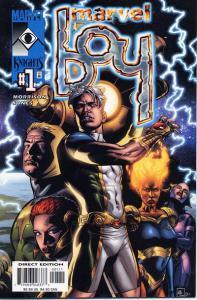
So, while I was already there I decided give some other X-Men a go. Chris Claremont went to X-Treme X-Men, after his return didn’t work out. I gave it a chance. Chuck Austin in Uncanny was, unfortunately, considered among the worst runs ever.
Geoff Johns on Avengers, as said.
Then, Mark Waid got to write Fantastic Four! A lot of fun, and joined by the late Mike Weiringo of Flash fame. The first family of the Marvel Universe were seen as ‘imaginauts,’ as they explored time and space and other universes. Doctor Doom got a bit of an occultic retcon, and it was well done indeed. I love when Fantastic Four is done right.
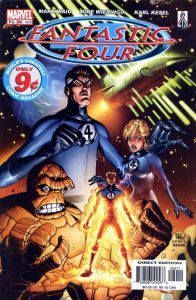
Earth X came out in 1999, but I read the graphic novel a year or so later. Created by Alex Ross initially (written by Jim Kreuger) following DC’s Kingdom Come, the dystopian premise was a future in which everyone has super powers except for Captain America.
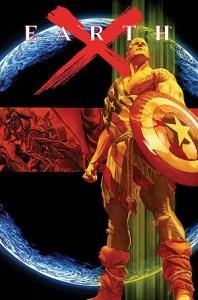
Jim Kreuger followed it up with Universe X and Paradise X, and I read all with great anticipation. Kreuger told a sort of final chapter to the Marvel Comics saga, revealing every secret character by character, giving a bittersweet farewell to everyone from Spider-Man to Galactus…
(Do prepare to see a lot of pics with Captain America standing there inspiringly, in this blog)
Meanwhile, the next big thing was to be the Ultimate Universe. Starting with Ultimate Spider-Man — written by Bendis whom I rarely cared for — it was a separate reality that was supposed to reboot everything for the sake of newer readers. Unburdened by decades of continuity, the Ultimate universe started anew with fresh modern takes on the various franchises.
Marvel Millar wrote Ultimate X-Men, and it was not good at all. Millar is an interesting writer; he’s pretty much a hack and yet a very entertaining hack. These days he’s only concerned with making comics to serve as movie pitches, such as Kick-Ass and Secret Service.
There was one masterpiece that stood out. Ultimates, by Millar and brilliant artist Bryan Hitch. That is, specifically the 13-issue Ultimates and sequal 13-issue Ultimates 2.
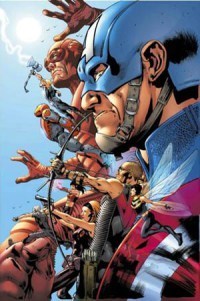
There wouldn’t even be the Avengers film phenomenon if not for Ultimates.
Millar was very successful at turning the Avengers into an incredibly awesome action movie franchise. Of the ‘widescreen’ style, written snarkily like the wittiest rated R cult classic, there was Captain America as WWII badass, homicidal Hulk, and biggest impact of all was Tony Stark/Iron Man as self-obsessed genius asshole. Thor as a new age guru was an interesting take. The super team and S.H.E.I.L.D. were all presented bit fascistic if you analyze too much, yet what a ride.
Very quotable. Cap: “SURRENDER??!! You think this letter on my head stands for France?” And when the villains overtake Manhattan: “The Great Satan has been liberated.”
With the climax of the first volume fighting aliens, familiar? I must admit I am definitely invested in the Marvel Cinematic Universe, and I fully give the Ultimates their do!
Other Mark Millar impacts included the crossover Civil War. Which will be getting a movie.
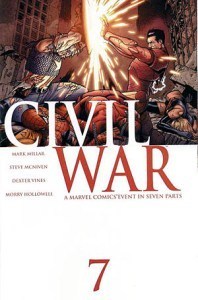
I didn’t read most crossovers of that decade. Secret Invasion by Bendis, no way. Fear Itself, yawn. Civil War was on of those cynical ‘realistic superhero’ tales in which Captain America goes to war with Iron Man over government registration of superhumans. The trade reprint seemed worth a read at the bookstore but not buying.
Spider-Man famously gave up his secret identity at the time, siding with Iron Man and revealing himself on camera as Peter Parker. Obviously, there was a retcon soon after and that never happened; back to the ol’ status quo for Spidey.
Afterwards, Cap was assassinated and resurrected Bucky/Winter Soldier replaced him for a while. I read some of Ed Brubaker’s run, it was critically acclaimed and so on, but kind of boring with all the predictable resurrections.
Lastly, Avengers vs. X-Men. In order to get into that, allow me to introduce Jason Aaron.
A very interesting writer, I came across Aaron by way of his war graphic novel The Other Side from Vertigo. He also created the Native American crime comic Scalped, but soon became most successful with Marvel superheroes. Wolverine writer of all things. I didn’t read much of that sort, but I did check out Wolverine and the X-Men. It was funny and weird scifi and even referenced the Grant Morrison era. Not bad. By the 2010s (and don’t forget I had now been living abroad), it was my first time in years reading X-Mens.
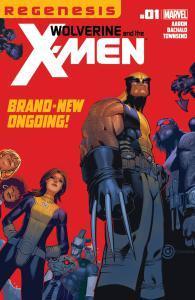
And then… came the epic crossover Avengers vs X-Men, cowritten by Aaron himself. It also signaled the end of the horrible Bendis New Avengers era and I supported. One thing in particular I hated New Avengers was Wolverine as an Avenger, which was kind of a major plot point by then with him stuck in the middle. Doesn’t anyone ever get tired of Wolverine?
Basically just a fun read, big dumb fighting as the Phoenix force came to Earth and the mutants fought against Earth’s Mightiest Heroes for the future of their race and/or saving the world. Cyclops went evil, man.
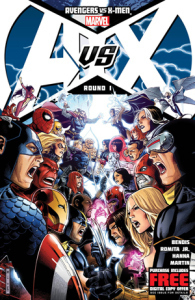
On a final note, the works of writer Jonathan Hickman:
Fantastic Four again, Hickman’s run was cosmic. After hearing about the buzz, I read the whole thing online and I wasn’t disappointed. Although the death-rebirth thing with the Human Torch was a bit too much resurrection already, such a comic cliché. I really enjoyed the alternate Reed Richardses and Celestials and Infinity Gauntlets.
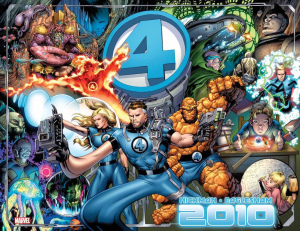
Hickman has currently been writing the core title Avengers over the last several years, and I have been doing my best to read them as the come out. It’s all about to come to a head, after some excruciatingly slow cosmic buildup (crossover Infinity in the middle there) with the climax any day now. The Illuminati, Tony Stark’s redemption, multiple earths crashing into each other, etc.
Secret War will be the big deal finale, and Hickman will be in charge of Marvel’s first ever across-the-board complete reboot. The Ultimate Universe will be gone too.
Should I take that as a cue to stop with the Marvel, or should I read more to see what happens next?
And those are the Marvel Comics I read as an adult. Colorful. Enjoyable. Good guys versus bad guys. Not really the most literary thing in the world. I may or may not be growing out of this. The truth is deep down I kinda can’t stop loving it.
Notice I have left out writer-artist Jim Starlin, creator of Thanos and the Infinity Gauntlet and master of all things cosmic. Some of which Hickman himself heavily referenced in Fantastic Four and Avengers.
Also, Starlin produced the greatest Marvel Comics of the 1970s (prior to my personal birth but well worth going back to read), before bringing it all back in my 90s childhood, and he still produces fine work to this day. I will have more to say shortly.
Next: Jim Starlin and Marvel Comics of the 1970s


April 18, 2015
Suspending serves
I went to the supermarket, this lane was closed.
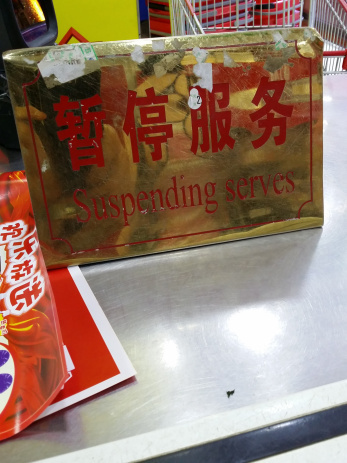
Also: this isn’t Chinglishy but rather surprisingly racist whatever it’s supposed to mean…



April 12, 2015
Gail Simone – more DC 2000s, and brief word on women in comics
Previous: DC Comics – 2000s
It’s been said that the comics scene — American superhero comics specifically, at least –is too much of a boy’s club. There are some legitimate criticisms in that, and I hope the field will prove more inclusive in the future.
I did like Louise Simonson’s 80s X-Men spinoffs, and Ann Nocenti’s Daredevil. Persepolis by Marjane Satrapi in the more indie vein. I grew up with Rumiko Takahashi’s Ranma 1/2 as for Japanese manga. Japan has always had plenty of female-friendly markets, and independent comics are surely more diverse.
Yet I have to admit that throughout the 2000s, the largest bulk of my reading centered on mainstream comics (mostly DC) by these authors: Geoff Johns, Grant Morrison, and Mark Waid.
Do allow me to add one more to the list: Gail Simone!
And I hope I’m not coming across as too affirmative actiony here, I really am a big fan.
Ms. Simone started out gaining prominence in the scene with her Women in Refrigerators blog, making the point that violence against women is often a plot point to motivate the male protagonist. And that’s not a very cool thing if you want to get more readers of the other 50% of the population.
She started writing Deadpool for Marvel, though I never read it I have heard good things, helping to build up the popularity of the character who is getting a movie. Deadpool is dark comedy, which is one of Simone’s best styles.
She truly has a brilliantly sick sense of humor.
For me, it began with Birds of Prey by Chuck Dixon. The series was great, as previously mentioned Barbara Gordon had become crippled and turned her talents towards being a sort of superhero tech operator. She mainly sent Black Canary on Bond-esque missions.
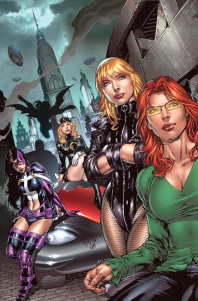
Gail Simone took over the writing, and Oracle was further joined by Huntress and Lady Blackhawk. The series actually became even better.
There was a hiatus, and at the Brightest Day event she returned to Birds of Prey with a new number 1 and it was most certainly on my pull list. Although that only lasted 12 issues, because of Flashpoint. See why I don’t like reboots?
I enjoyed Birds of Prey plenty, and then I became a rather hardcore fan during the Villains United minseries as as part of Infinite Crisis crossover.
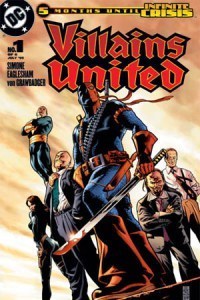
The premise was that all the villains were teaming up into a grand secret society, with an inner circle led by Deathstroke, Black Adam, Lex Luthor, and Talia al Ghul.
Villains United wasn’t actually about the society, it was about a ragtag group of villains who wouldn’t play along. Deadshot, from the old Suicide Squad I loved, and a re-amped Catman, Rag Doll, Bane, and the new character their leader Scandal Savage — the daughter of Vandal Savage They became the mercenary group Secret Six (I’d list all six, but it wasn’t stable as some died and were replaced).
I knew something awesome was in the works. Best antihero villains-themed cover ever. The Six eventually got another miniseries, and then a long-running series that I followed to the bitter end. More below.
Simone wrote Wonder Woman for a while there by the way, and it was very well-received. So rarely is the character done right, a lot of those mythological epics are hard to do well. The new mega-villain Genocide was introduced. With a tweaked origin and a barbarian saga in mind, ’twas no George Perez but still quite good.
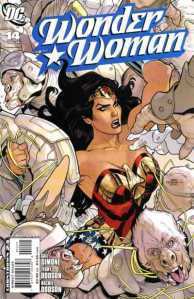
And then I moved to China in late ’08.
I continued to read Secret Six throughout my time in China. I brought all my back issues with me. Bought the new ones at my comic shop in Hong Kong.
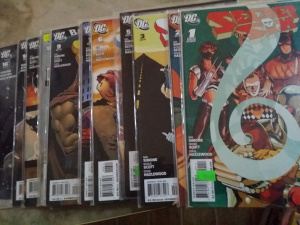
My favorite was when they even crossed over with a resurrected zombie Suicide Squad during the Blackest Night event.
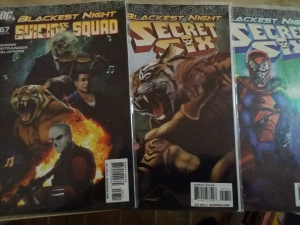
I did run out of steam eventually, and stopped buying new issues. I just settled on the final three graphic novel collections. At last they fought the Secret 666 all the way to the depths of hell. And that was it, the series was over with issue 36. I’ll miss you, Secret Six and Gail Simone.
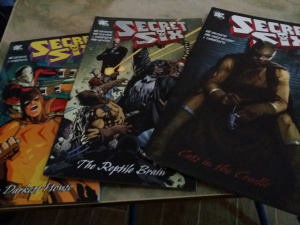
Sadly, I didn’t read Gail Simone’s Batgirl whatsoever. I am philosophically against it. After the New 52 began, Batgirl was miraculously healed and is no longer the overseer Oracle. She’s just back to being a physical superhero, which disregards the previous Batgirl and makes Babs less of an intellectual force.
I assumed the new status quo wouldn’t be my thing. I let go of a lot after New 52, sorry.
I hear the series is good.
And that covers a whole lot of DC.
What to go over next? Perhaps a return to the eternal Marvel debate. While I was mostly about DC in the decade of my burgeoning adulthood, I did enjoy more than a bit of Marvel in the aughties.
Next: Marvel Comics – 2000s


April 8, 2015
Geoff Johns – DC Comics 2000s
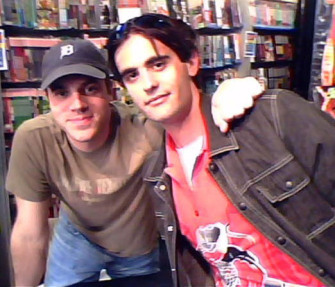
Met at comic shop opening L.A. Comic writers are always such nice guys.
Geoff Johns largely WAS the face DC Comics of the 2000s, in my twenty-something resurgence as a hardcore comics geek I basically read every single one of his books that entire decade.
Note: Goodreads Shelf: Geoff Johns — that 68 at last count
Johns is not going to win any big literary awards and change your life, and that’s not the point. He is a great entertainer, a great storyteller, never dumbing down and utilizing the best aspects of the superhero genre. Throughout the 2000s, he was particularly skilled at taking complex continuity and streamlining into a way that pleased hardcore fans and newcomers alike. Nowadays is a different story, but that’s what it was like at the time.
I remember first discovering the former screenwriter’s first published Stars and S.T.R.I.P.E. at the very beginning, a certain humble 12-issue series about the Star-Spangled Kid, an update on old Golden Age retired heroes. It was the perfect start. Nothing grim and gritty (although later I’d learned the main character Courtney Whitmore was based on Johns’ deceased sister), just fun comics with respect towards history.
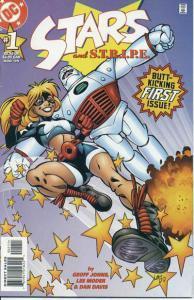
This also concerns Starman. Written by James Robinson in the 90s, Starman was one of DC’s finest works. Another legacy comic about a modern take on the Golden Age, Starman was very different from the norm. Jack Knight might be called a hipster hero today. His dad was the original Starman, and he was a normal, cultural guy with tattoos and good taste in movies, forced into the life.
Ultimately James Robinson ushered in the new JSA: the Justice Society of America. Thanks must also go to the success of the JLA at the same time, and DC was trying harder with classic team books.
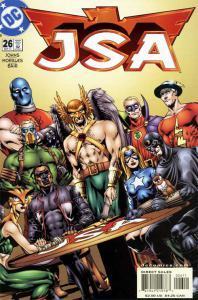
Geoff Johns wrote from issue 5 and up to the end, and it was something special indeed. Unlike previous incarnations of these characters in Infinity Inc., the new book was ambitious and quickly became the centerpiece of the DC Universe. Arguably more crucial than the Justice League themselves. The society saved the world, introduced new mythos, let the original Flash and Green Lantern and Wildcat mentor the next generation, and not to mention a return to glory for Hawkman.
As for solo heroes, Geoff Johns took over The Flash…
This was back in the Wally West days, not Barry Allen like the new show currently airing. Barry had died way back in the Crisis on Infinite Earths event in the 80s, long replaced by his now grown sidekick. Wally was more of an everyman hero, without a secret identity, but still very much in the mainstream superhero scene.
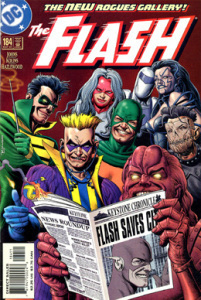
Flash already had very high standards, thanks to the extremely talented Mark Waid, and Johns – joined by artist Scott Kollins – focused on Wally as a sort of working class hero in a pseudo-Detroit. The villains were given the utmost important, with the Rogue’s Gallery often being the stars.
The Flash became my favorite hero of all.
I still really miss Wally West…
Geoff Johns was gaining traction, and got noticed by Marvel Comics. He had a brief run over on the flagship title The Avengers, as well some other miniseries such as The Vision and The Thing. He did as well there as expected – he was perfectly suited to Captain American in particular. Sadly, it was over all too fast and Johns signed on to be exclusive with DC and the run abruptly ended after a mere 20 issues. Avengers after that became New Avengers by Bendis and I was no fan; that was point I cut off all Marvel and focused only on DC.
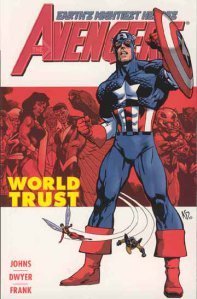
Geoff Johns kept going. Teen Titans debuted, fusing the 80s Titans fused with Young Justice. I didn’t love the art and I kinda missed Peter David, but it was very much worth reading. Robin, Superboy (now revealed to be… spoiler ahead… Lex Luthor’s clone!), and Impulse took up the mantle of Kid Flash.
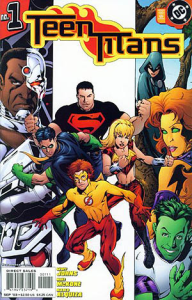
This would not be a post about Geoff Johns however, if I did not speak of his epics of epics: Green Lantern!
(Note many of the pics below I simply took myself, as I thought these comics worth saving in my China apartment right now)
Green Lantern had a tough time in the 90s. Hal Jordan, of the classic Silver Age era, went evil during the Death of Superman and Zero Hour events. Johns himself did try to redeem Hal as his ghost became the new Spectre in the Day of Judgment crossover.
It really changed in Green Lantern: Rebirth, which brought Hal back to life and returned the Green Lantern Corps to prominence. Kyle Rayner, the 90s-era replacement, even got to stick around.
It was a bit convoluted with the revelation that the Parallax fear energy being had possessed Hal Jordan and caused him to turn evil. Now he was back without even the grey in his hair. Personally, I always liked the corps and the outer space opera of Green Lantern, although I was apprehensive at first at the return of the status quo.
What was really cool – and most obvious in retrospect – was the new villainous force of the yellow Sinestro Corps. That blew up into even more with colors, and more on that shortly.
By the mid-2000s, Geoff Johns was now firmly in place as the leader of the DC. Infinite Crisis was his next major crossover, focusing on the challenges of DC’s core trinity: Superman, Batman, and Wonder Woman. He referenced Crisis on Infinite Earths and brought back the original Superman of Earth 2. It was a continuity-heavy, I’ll admit.
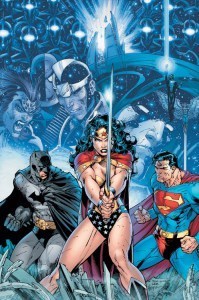
After Infinite Crisis, DC did a time-skip in which all titles jumped to a year in the future. Some of these were more successful than others, but it was an interesting method to get new readers and have a fresh start. Geoff Johns wrote more than a few Superman titles at the center of it.
Most interesting of all was 52, the world’s first “real time comic” with every issue of the one-year-long series taking place in one week within the gap year. Cowritten by Grant Morrison and Mark Waid (also Greg Rucka whom I don’t mostly care for but was more of a Batman-side DC writer, and his Wonder Woman run was okay too), ’twas some top-notch writing. The premise was the trinity was gone all year and it was up to Booster Gold and Question and other lesser heroes to save the day!
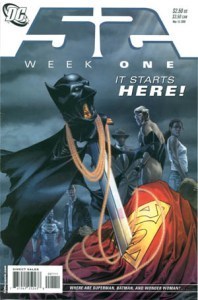
The year was 2008. Final Crisis was the scheduled annual event, headed by Grant Morrison. I read, I read.
And later that autumn I was to move from California to Shenzhen, China. One of the biggest challenges to moving abroad was how to deal with my comics hobby. I already mailed my entire collection coast-to-coast more than once. Not worth it internationally so; and today most of these comics are in some family closet gathering dust.
I am glad I moved to China and turned my life around, but that was honestly the hardest part. What can I say.
I was determined to keep up with reading Green Lantern. Not to mention others such as Grant Morrison’s Batman, One Piece and Naruto in the manga world, and Gail Simone’s Secret Six which I will get into next post.
I did bring a few trades to reread. But I needed more. Asking relatives to mail me comics wasn’t really working. Luckily, I live in Shenzhen which borders Hong Kong — the former British colony still a very Westernized city. There’re the Page One bookstores which have decent graphic novel selections. And, I discovered Hong Kong has not one but two English-language comic shops! I made the trek past the border twice a month for a while there, making friends with my comic guy and reserving all my favorite titles.
Do check out Clark’s Comics if you’re ever in the Causeway Bay area.
So my comics habit had continued unabated. It was 2009, and Geoff Johns was ready to let Barry Allen follow in Hal Jordan’s footsteps and come back to life in the pages of Flash: Rebirth.
And then. Finally. At the cusp of a new decade, deep into the 21st century, came the pinnacle of all that Geoff Johns had been working towards all these years.
Blackest Night.
Green Lantern had been leading up to Blackest Night the entire time. It had turned out that there was a whole spectrum of different colored corps, each corresponding to an emotion.Green represented willpower, and the yellow light of Sinestro was fear, etc. There was blue for hope, indigo for compassion, and more. It was growing into a very broad mythology.
Most evil of all were the Black Lanterns, who were basically undead zombies. In trying gain an emotional reactions for the purposes of sucking energy from their victims, corpses rose from the dead from all over the DCU. It was enticing storytelling, epic in scope, incorporating the theme of superhero resurrections in a terribly valid way. Hal Jordan and Barry Allen, back to life, fighting together again against the forces of death.
It was so much fun going to my HK comic shop to find each tie-in issue and read them as soon as I could. That’s the thing about comics, as much as graphic novels are more literary, it’s the most fun to read the stories right as they’re published and get that sense of cliffhanging urgency.
Of course, the good guys won in the end, but just barely. The status quo had been unraveled, and next was the Brightest Day biweekly series. I ate that stuff up over the next year, still fully a DC fan though an expat transplanted in faroff Asia.
Sadly, this pace could not go on unabated. DC ran out of steam eventually, and they had to reboot it all.
Flashpoint was about grimmy alternate realities or something. After the fact I got the graphic novel, but no tie-ins. Not my favorite, not my kind of thing.
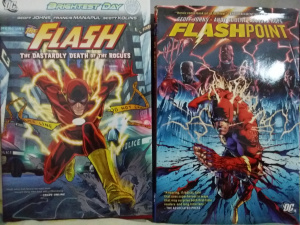
The new universe was called the New 52, and everything had started over. Sure Action Comics and Batman Inc were worth checking out (re: the Grant Morrison pattern therein). But I only followed up on Green Lantern online. Justice League by Geoff Johns and Jim Lee was to be the core DC book, and yet it wasn’t for me. The whole thing felt like it was trying to be an action movie now, not a quality TV show. No sense of history or continuity. I suppose my ilk of comics fan was never meant to last forever, and it’s more important to gain new readers. Ah well.
I don’t buy comics as they come out anymore. I buy the trade reprints months or years later, if at all. Something like the Forever Evil crossover is only worth skimming at a bookstore. I’m just not that invested anymore.
For a while there though, DC was it and Geoff Johns was the very center.
Maybe one day again.
For now, I will keep and cherish my lovely memories of the magic that was the DC Universe.
Bonus:
Mark Waid and the Legion of Super-heroes
I’m almost done here, and it comes to mind that Mark Waid deserves a post all his own. Yet I can only fit so much, and I’ve already mostly gone his authorship over in the DC 90s and Superman post (and later I’ll get into his Fantastic Four run in my future Marvel 2000s).
Also, I was a big fan of Legion of Superheroes and there’s that.
So let me get into the Legion for a bit.
In the Silver Age, Superboy was a member of a 30th century team of super teens. In the 80s, writer Paul Levitz built up a fond science fiction mythology upon the esteemed heroes of the United Planets. Founders Cosmic Boy, Lightening Lad, and Saturn Girl joined by Chameleon Boy, Braniac 5, Blok, Ultra Boy, Star Boy, Triplicate Girl, Wildfire, Phantom Girl, Invisible Boy, Shrinking Violet, and so many many more. It was colorful times.
I got into it a bit later though, when Mark Wait created the reboot after Zero Hour in the 90s. Starting from scratch, it was perfect for me. Late in the game, I tracked down every single issue at conventions and back issue bins. In an era of gritty dystopias, it was a positive future to look forward to. I always liked outer space and time travel meself. They also had the coolest futuristic villains.
There was a ‘threeboot’ in the 2000s also written by Mark Waid. Later still, Geoff Johns brought back the classic pre-Crisis Legion, and wrote the Final Crisis: Legion of 3 Worlds to streamline the whole thing and give a dignified finale to Waid’s era(s).
Love Live the Legion!
* * *
Geoff Johns. Grant Morrison. Mark Waid.
Those are a lot of white male authors I enjoy. Nothing wrong with that, but perhaps there should be more diversity in comics. It’s been said that the American industry has always been too much of a boy’s club, and perhaps that is a legitimate criticism.
Don’t fret. One of favorite authors is indeed of the female persuasion, and writes as badass as anyone. Birds of Prey and the Secret Six.
Next: Gail Simone



